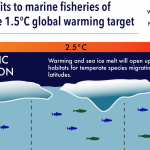Variations in climate lead to fluctuations and changes in fish stocks; they can have effects on such things as fish behaviour, distributions and growth. Because of this, fisheries management has to respond dynamically to these fluctuations. If management decisions are made primarily on past patterns, the negative impacts can be exacerbated, especially with climate change. A new paper in Progress in Oceanography co-authored by Nereus Program Principal Investigator Charles Stock (NOAA), Alumnus Rebecca Asch (East Carolina University), PI Malin Pinsky (Rutgers), and Alumnus Ryan Rykaczewski (University of South Carolina) looks at seasonal to decadal forecasts for living marine resources and their prospects and challenges.
The paper is a result of the workshop “Applications of Seasonal to Decadal Climate Predictions for Marine Resource Management” held at Princeton University on June 3 to 5, 2015. In it, the authors explain different climate prediction systems and their strengths and limitations, as well as summarize climate-sensitive decisions made within fisheries management and the possibility for expanded use of climate predictions in marine resource management.

Climate change can cause variations in fish distributions, growth rates, behaviours and more. Fisheries management must be dynamic and respond to these changes.
Abstract
Recent developments in global dynamical climate prediction systems have allowed for skillful predictions of climate variables relevant to living marine resources (LMRs) at a scale useful to understanding and managing LMRs. Such predictions present opportunities for improved LMR management and industry operations, as well as new research avenues in fisheries science. LMRs respond to climate variability via changes in physiology and behavior. For species and systems where climate-fisheries links are well established, forecasted LMR responses can lead to anticipatory and more effective decisions, benefitting both managers and stakeholders. Here, we provide an overview of climate prediction systems and advances in seasonal to decadal prediction of marine-resource relevant environmental variables. We then describe a range of climate-sensitive LMR decisions that can be taken at lead-times of months to decades, before highlighting a range of pioneering case studies using climate predictions to inform LMR decisions. The success of these case studies suggests that many additional applications are possible. Progress, however, is limited by observational and modeling challenges. Priority developments include strengthening of the mechanistic linkages between climate and marine resource responses, development of LMR models able to explicitly represent such responses, integration of climate driven LMR dynamics in the multi-driver context within which marine resources exist, and improved prediction of ecosystem-relevant variables at the fine regional scales at which most marine resource decisions are made. While there are fundamental limits to predictability, continued advances in these areas have considerable potential to make LMR managers and industry decision more resilient to climate variability and help sustain valuable resources. Concerted dialog between scientists, LMR managers and industry is essential to realizing this potential.








